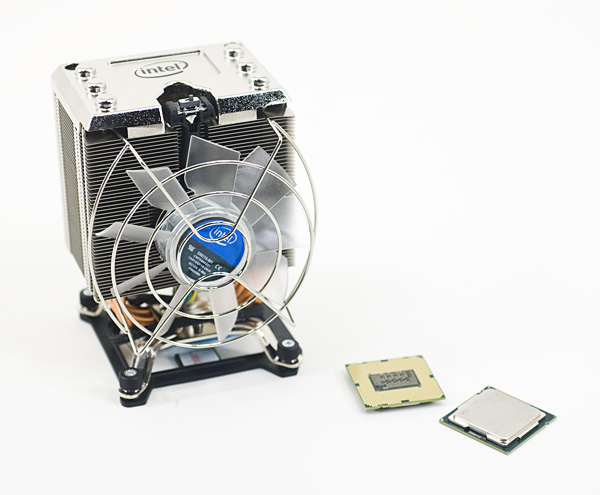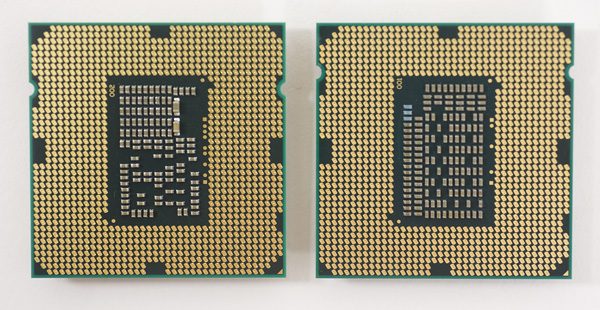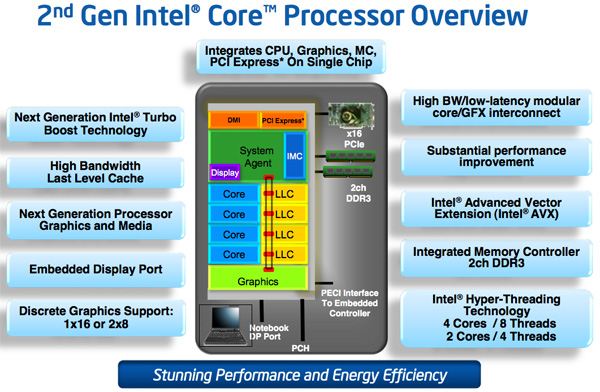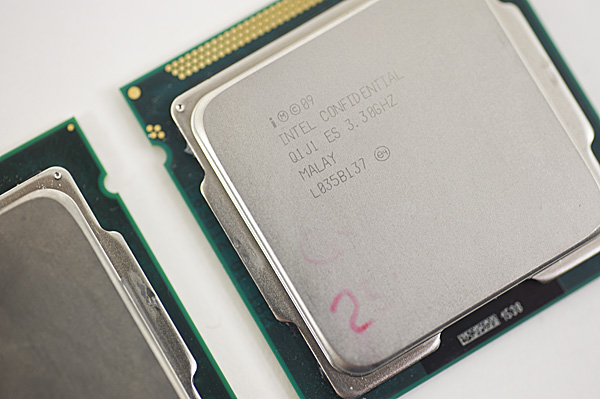The Sandy Bridge Review: Intel Core i7-2600K, i5-2500K and Core i3-2100 Tested
by Anand Lal Shimpi on January 3, 2011 12:01 AM ESTIntel never quite reached 4GHz with the Pentium 4. Despite being on a dedicated quest for gigahertz the company stopped short and the best we ever got was 3.8GHz. Within a year the clock (no pun intended) was reset and we were all running Core 2 Duos at under 3GHz. With each subsequent generation Intel inched those clock speeds higher, but preferred to gain performance through efficiency rather than frequency.
Today, Intel quietly finishes what it started nearly a decade ago. When running a single threaded application, the Core i7-2600K will power gate three of its four cores and turbo the fourth core as high as 3.8GHz. Even with two cores active, the 32nm chip can run them both up to 3.7GHz. The only thing keeping us from 4GHz is a lack of competition to be honest. Relying on single-click motherboard auto-overclocking alone, the 2600K is easily at 4.4GHz. For those of you who want more, 4.6-4.8GHz is within reason. All on air, without any exotic cooling.
Unlike Lynnfield, Sandy Bridge isn’t just about turbo (although Sandy Bridge’s turbo modes are quite awesome). Architecturally it’s the biggest change we’ve seen since Conroe, although looking at a high level block diagram you wouldn’t be able to tell. Architecture width hasn’t changed, but internally SNB features a complete redesign of the Out of Order execution engine, a more efficient front end (courtesy of the decoded µop cache) and a very high bandwidth ring bus. The L3 cache is also lower and the memory controller is much faster. I’ve gone through the architectural improvements in detail here. The end result is better performance all around. For the same money as you would’ve spent last year, you can expect anywhere from 10-50% more performance in existing applications and games from Sandy Bridge.
I mentioned Lynnfield because the performance mainstream quad-core segment hasn’t seen an update from Intel since its introduction in 2009. Sandy Bridge is here to fix that. The architecture will be available, at least initially, in both dual and quad-core flavors for mobile and desktop (our full look at mobile Sandy Bridge is here). By the end of the year we’ll have a six core version as well for the high-end desktop market, not to mention countless Xeon branded SKUs for servers.
The quad-core desktop Sandy Bridge die clocks in at 995 million transistors. We’ll have to wait for Ivy Bridge to break a billion in the mainstream. Encompassed within that transistor count are 114 million transistors dedicated to what Intel now calls Processor Graphics. Internally it’s referred to as the Gen 6.0 Processor Graphics Controller or GT for short. This is a DX10 graphics core that shares little in common with its predecessor. Like the SNB CPU architecture, the GT core architecture has been revamped and optimized to increase IPC. As we mentioned in our Sandy Bridge Preview article, Intel’s new integrated graphics is enough to make $40-$50 discrete GPUs redundant. For the first time since the i740, Intel is taking 3D graphics performance seriously.
| CPU Specification Comparison | ||||||||
| CPU | Manufacturing Process | Cores | Transistor Count | Die Size | ||||
| AMD Thuban 6C | 45nm | 6 | 904M | 346mm2 | ||||
| AMD Deneb 4C | 45nm | 4 | 758M | 258mm2 | ||||
| Intel Gulftown 6C | 32nm | 6 | 1.17B | 240mm2 | ||||
| Intel Nehalem/Bloomfield 4C | 45nm | 4 | 731M | 263mm2 | ||||
| Intel Sandy Bridge 4C | 32nm | 4 | 995M | 216mm2 | ||||
| Intel Lynnfield 4C | 45nm | 4 | 774M | 296mm2 | ||||
| Intel Clarkdale 2C | 32nm | 2 | 384M | 81mm2 | ||||
| Intel Sandy Bridge 2C (GT1) | 32nm | 2 | 504M | 131mm2 | ||||
| Intel Sandy Bridge 2C (GT2) | 32nm | 2 | 624M | 149mm2 | ||||
It’s not all about hardware either. Game testing and driver validation actually has real money behind it at Intel. We’ll see how this progresses over time, but graphics at Intel today very different than it has ever been.
Despite the heavy spending on an on-die GPU, the focus of Sandy Bridge is still improving CPU performance: each core requires 55 million transistors. A complete quad-core Sandy Bridge die measures 216mm2, only 2mm2 larger than the old Core 2 Quad 9000 series (but much, much faster).
As a concession to advancements in GPU computing rather than build SNB’s GPU into a general purpose compute monster Intel outfitted the chip with a small amount of fixed function hardware to enable hardware video transcoding. The marketing folks at Intel call this Quick Sync technology. And for the first time I’ll say that the marketing name doesn’t do the technology justice: Quick Sync puts all previous attempts at GPU accelerated video transcoding to shame. It’s that fast.
There’s also the overclocking controversy. Sandy Bridge is all about integration and thus the clock generator has been moved off of the motherboard and on to the chipset, where its frequency is almost completely locked. BCLK overclocking is dead. Thankfully for some of the chips we care about, Intel will offer fully unlocked versions for the enthusiast community. And these are likely the ones you’ll want to buy. Here’s a preview of what’s to come:
The lower end chips are fully locked. We had difficulty recommending most of the Clarkdale lineup and I wouldn’t be surprised if we have that same problem going forward at the very low-end of the SNB family. AMD will be free to compete for marketshare down there just as it is today.
With the CPU comes a new platform as well. In order to maintain its healthy profit margins Intel breaks backwards compatibility (and thus avoids validation) with existing LGA-1156 motherboards, Sandy Bridge requires a new LGA-1155 motherboard equipped with a 6-series chipset. You can re-use your old heatsinks however.

Clarkdale (left) vs. Sandy Bridge (right)
The new chipset brings 6Gbps SATA support (2 ports) but still no native USB 3.0. That’ll be a 2012 thing it seems.













283 Comments
View All Comments
GeorgeH - Monday, January 3, 2011 - link
With the unlocked multipliers, the only substantive difference between the 2500K and the 2600K is hyperthreading. Looking at the benchmarks here, it appears that at equivalent clockspeeds the 2600K might actually perform worse on average than the 2500K, especially if gaming is a high priority.A short article running both the 2500K and the 2600K at equal speeds (say "stock" @3.4GHz and overclocked @4.4GHz) might be very interesting, especially as a possible point of comparison for AMD's SMT approach with Bulldozer.
Right now it looks like if you're not careful you could end up paying ~$100 more for a 2600K instead of a 2500K and end up with worse performance.
Gothmoth - Monday, January 3, 2011 - link
and what benchmarks you are speaking about?as anand wrote HT has no negative influence on performance.
GeorgeH - Monday, January 3, 2011 - link
The 2500K is faster in Crysis, Dragon Age, World of Warcraft and Starcraft II, despite being clocked slower than a 2600K. If it weren't for that clockspeed deficiency, it looks like it also might be faster in Left 4 Dead, Far Cry 2, and Dawn of War II. Just about the only game that looks like a "win" for HT is Civ5 and Fallout 3.The 2500K also wins the x264 HD 3.03 1st Pass benchmark, and comes pretty close to the 2600K in a few others, again despite a clockspeed deficiency.
Intel's new "no overclocking unless you get a K" policy looks like it might be a double-edged sword. Ignoring the IGP stuff, the only difference between a 2500K and a 2600K is HT; if you're spending extra for a K you're going to be overclocking, making the 2500K's base clockspeed deficiency irrelevant. That means HT's deficiencies won't be able to hide behind lower clockspeeds and locked multipliers (as with the i5-7xx and i7-8xx.)
In the past HT was a no-brainer; it might have hurt performance in some cases but it also came with higher clocks that compensated for HT's shortcomings. Now that Intel has cut enthusiasts down to two choices, HT isn't as clear cut, especially if those enthusiasts are gamers - and most of them are.
Shorel - Monday, January 3, 2011 - link
I don't ever watch soap operas (why somebody can enjoy such crap is beyond me) but I game a lot. All my free time is spent gaming.High frame rate reminds me of good video cards (or games that are not cutting edge) and the so called film 24p reminds me of the Michael Bay movies where stuff happens fast but you can't see anything, like in transformers.
Please don't assume that your readers know or enjoy soap operas. Standard TV is for old people and movies look amazing at 120hz when almost all you do is gaming.
mmcc575 - Monday, January 3, 2011 - link
Just want to say thanks for such a great opening article on desktop SNB. The VS2008 benchmark was also a welcome addition!SNB launch and CES together must mean a very busy time for you, but it would be great to get some clarification/more in depth articles on a couple of areas.
1. To clarify, if the LGA-2011 CPUs won't have an on-chip GPU, does this mean they will forego arguably the best feature in Quick Sync?
2. Would be great to have some more info on the Overclocking of both the CPU and GPU, such as the process, how far you got on stock voltage, the effect on Quick Sync and some OC'd CPU benchmarks.
3. A look at the PQ of the on-chip GPU when decoding video compared to discrete low-end rivals from nVidia and AMD, as it is likely that the main market for this will be those wanting to decode video as opposed to play games. If you're feeling generous, maybe a run through the HQV benchmark? :P
Thanks for reading, and congrats again for having the best launch-day content on the web.
ajp_anton - Monday, January 3, 2011 - link
In the Quantum of Solace comparison, x86 and Radeon screens are the same.I dug up a ~15Mbit 1080p clip with some action and transcoded it to 4Mbit 720p using x264. So entirely software-based. My i7 920 does 140fps, which isn't too far away from Quick Sync. I'd love to see some quality comparisons between x264 on fastest settings and QS.
ajp_anton - Monday, January 3, 2011 - link
Also, in the Dark Knight comparison, it looks like the Radeon used the wrong levels (so not the encoder's fault). You should recheck the settings used both in the encoder and when you took the screenshot.testmeplz - Monday, January 3, 2011 - link
Thanks for the great reveiw! I believe the colors in the legend of the graphs on the Graphics overclocking page are mixed up.THanks,
Chris
politbureau - Monday, January 3, 2011 - link
Very concise. Cheers.One thing I miss is clock-for-clock benchmarks to highlight the effect of architectural changes. Though not perhaps within the scope of this review, it would nonetheless be interesting to see how SNB fairs against Bloomfield and Lynnfield at similar clock speeds.
Cheerio
René André Poeltl - Monday, January 3, 2011 - link
Good performance for a bargain - that was amd's terrain.Now sandy bridge for ~200 $ targets on amd's clientel. A Core i5-2500K for $216 - that's a bargain. (included is even a 40$ value gpu) And the overclocking ability!
If I understood it correctly: Intel Core i7 2600K @ 4.4GHz 111W under load is quite efficient. At 3.4 ghz 86 W and a ~30% more 4.4 ghz = ~30% more performance ... that would mean it scales ~ 1:1 power consumption/performance.
Many people need more performance per core, but not more cores. At 111 W under load this would be the product they wanted. e.g. People who make music with pc's, not playing mp3's but mixing, producing music.
But for more cores the x6 Thuban is the better choice on a budget. For e.g. building a server on a budget intel has no product to rival it. Or developers - they may also want as many cores as they can get for their apps to test multithreading performance.
And Amd's also scores with their more conservative approach when it comes to upgrading e.g. motherboards. People don't like to buy a new motherboard every time they upgrade the cpu.